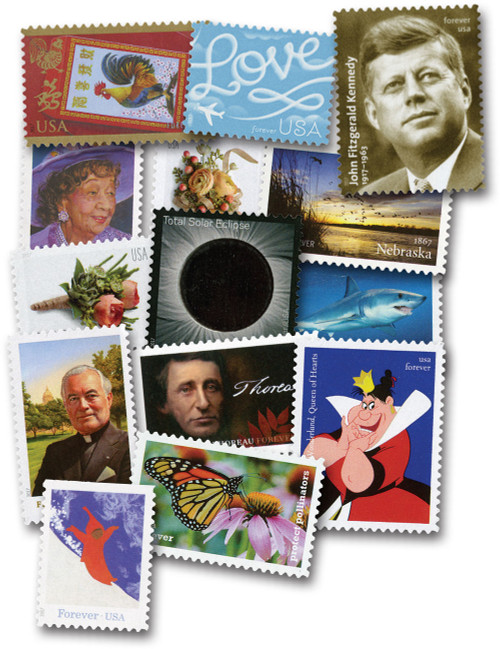
# 5193 - 2017 First-Class Forever Stamp - Delicioso: Flan
US #5193
2017 Flan – Delicioso
• Commemorates Latin American culinary traditions and how those traditions have impacted the food industry in the United States
Stamp Category: Commemorative
Set: Delicioso
Value: 49¢ First Class Mail (Forever)
First Day of Issue: April 20, 2017
First Day City: Albuquerque, New Mexico
Quantity Issued: 200,000,000
Printed by: Banknote Corporation of America
Printing Method: Offset, Microprint
Format: Double-sided Booklets of 20
Tagging: Phosphor Tagged Paper, Block
Why the stamp was issued: To honor one of the most popular Latin American dishes – flan.
About the stamp design: Pictures artwork by John Parra of flan. The design is bright and colorful with the name of the dish at the top of the stamp.
First Day City: The First Day of Issue Ceremony was held at the National Hispanic Cultural Center in Albuquerque, New Mexico.
About the Delicioso set: Issued to celebrate the influence of Central and South American, Mexican, and Caribbean cultures on American cuisine. Includes six designs picturing artwork by John Parra of: tamales, flan, sancocho, empanadas, chile relleno, and ceviche. The designs are bright and colorful with the name of each dish at the top of the each stamp.
History the stamp represents: A popular dessert or anytime treat in Mexico, flan (créme caramel) was first made by the Ancient Romans. Though, it was quite different from the sweet confection we know today.
Modern flan is a form of custard made from eggs and milk. It is poured into a mold coated in caramelized sugar, covered tightly, and baked.
The Ancient Romans had a surplus of eggs and began to experiment with new ways to use them. One of their creations was flan, a savory dish made with eggs, milk, eel, and pepper. They also occasionally made sweet versions with honey.
The Romans introduced new cultures to flan as they made their way across Europe. The Spanish were particularly fond of it and were the first to top it with a sweet caramel sauce. In turn, when the Spanish explored Mexico, they brought flan.
The Mexicans were also fascinated with the sweet treat and developed more varieties, which included coffee, chocolate, and coconut. The Mexicans did not always have ovens in their homes. Instead, they would place the flan on top of a pot of simmering water and caramelize the sugar with a flaming wooden paddle.
With roots in Ancient Rome and enhancements by other cultures, flan is a unique international dish.
US #5193
2017 Flan – Delicioso
• Commemorates Latin American culinary traditions and how those traditions have impacted the food industry in the United States
Stamp Category: Commemorative
Set: Delicioso
Value: 49¢ First Class Mail (Forever)
First Day of Issue: April 20, 2017
First Day City: Albuquerque, New Mexico
Quantity Issued: 200,000,000
Printed by: Banknote Corporation of America
Printing Method: Offset, Microprint
Format: Double-sided Booklets of 20
Tagging: Phosphor Tagged Paper, Block
Why the stamp was issued: To honor one of the most popular Latin American dishes – flan.
About the stamp design: Pictures artwork by John Parra of flan. The design is bright and colorful with the name of the dish at the top of the stamp.
First Day City: The First Day of Issue Ceremony was held at the National Hispanic Cultural Center in Albuquerque, New Mexico.
About the Delicioso set: Issued to celebrate the influence of Central and South American, Mexican, and Caribbean cultures on American cuisine. Includes six designs picturing artwork by John Parra of: tamales, flan, sancocho, empanadas, chile relleno, and ceviche. The designs are bright and colorful with the name of each dish at the top of the each stamp.
History the stamp represents: A popular dessert or anytime treat in Mexico, flan (créme caramel) was first made by the Ancient Romans. Though, it was quite different from the sweet confection we know today.
Modern flan is a form of custard made from eggs and milk. It is poured into a mold coated in caramelized sugar, covered tightly, and baked.
The Ancient Romans had a surplus of eggs and began to experiment with new ways to use them. One of their creations was flan, a savory dish made with eggs, milk, eel, and pepper. They also occasionally made sweet versions with honey.
The Romans introduced new cultures to flan as they made their way across Europe. The Spanish were particularly fond of it and were the first to top it with a sweet caramel sauce. In turn, when the Spanish explored Mexico, they brought flan.
The Mexicans were also fascinated with the sweet treat and developed more varieties, which included coffee, chocolate, and coconut. The Mexicans did not always have ovens in their homes. Instead, they would place the flan on top of a pot of simmering water and caramelize the sugar with a flaming wooden paddle.
With roots in Ancient Rome and enhancements by other cultures, flan is a unique international dish.










